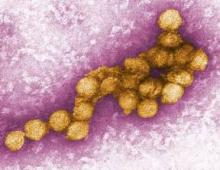Analyzing three local factors helps to predict when an epidemic of West Nile disease is imminent or has just begun, according to a report in the July 17 issue of JAMA.
This in turn should allow augmented mosquito control efforts and other measures such as public education to limit human illness from the virus just as an epidemic commences, said Dr. Wendy M. Chung of Dallas County Health and Human Services and her associates.
By studying these three factors – local weather patterns, the geographical distribution of recent outbreaks, and the current mosquito vector index (an estimate of the average number of virus-infected mosquitoes collected in surveillance traps each night) – public health specialists may be able to identify rapid rises in West Nile activity before it is too late to intervene. Until now, the best that such experts could do was to "wait to initiate augmented vector control until significant numbers of human cases and deaths [had been] reported."
This wait has allowed epidemics to take root, since the incubation period is 1-2 weeks between mosquito bite and symptom onset, and since there is a further 1- to 2-week delay for viral cultures to be completed and positive results to be reported to authorities, the investigators said.
Dr. Chung and her colleagues came to these conclusions after analyzing data from the 2012 resurgence in West Nile virus that occurred nationwide but was particularly damaging in the Dallas County area. "Dallas has been a known focus of mosquito-borne encephalitis since 1966," they noted, and had an ongoing surveillance program that included collecting mosquitos in traps.
Before the 2012 epidemic there, Dallas had enjoyed 5 years of relative quietude in West Nile virus activity.
Then, between May and early December 2012, 1,162 cases of West Nile viremia were reported in Dallas County; 398 cases of viral illness were confirmed, including 19 fatal cases. This "record-setting outbreak" began a month earlier than previous West Nile seasons had, and the number of new cases also escalated more rapidly than in previous seasons.
An additional 17 cases of West Nile viremia were identified among blood donors, which was more than twice the number of viremic blood donors identified during the previous outbreak. The overall incidence of West Nile disease in Dallas County was 7.30 per 100,000 residents in 2012, more than twice as high as the previous peak incidence of 2.91 per 100,000.
The demographic and clinical characteristics of cases in the 2012 outbreak were similar to those in previous outbreaks. In 2012, 96% required hospitalization, 35% intensive care, and 18% assisted ventilation. The case fatality rate was 10%.
An analysis of local weather patterns revealed that the winter preceding the 2012 epidemic was the mildest in a decade, with no hard winter freezes, a record peak in the number of days with above-normal temperatures, and a record peak in the amount of winter rains. Summer temperatures also were warmer than average that year, and there was less wind during the months that usually are windy.
These findings suggest that West Nile activity increases when extreme weather conditions favor mosquito survival over the winter, a longer period of mosquito-to-bird transmission in early spring, and an early start to human infections, Dr. Chung and her associates said (JAMA 2013;310:297-307).
An analysis of the geographic distribution of cases over time revealed a "repeated predilection of cases" in the northern region of the county, with a particular hot spot in a defined north-central location. "The census tracts in this high-risk hot spot were distinguished from those in other areas by higher property values, greater housing density, and a higher percentage of houses unoccupied (reflecting the current economic downturn)," the researchers wrote.
These findings concur with those of previous studies in metropolitan areas. Such neighborhoods have more neglected swimming pools, which increase mosquito populations, and less forestation, which allows greater viral amplification among birds. "Whatever the biological explanation, identifying a perennial geographical pattern of human infections should be useful in targeting such areas for more intensive public health prevention measures, including preseason source reduction, larviciding, and education," Dr. Chung and her associates wrote.
Finally, mosquito surveillance and screening for West Nile virus carriage allowed the calculation of a species-specific vector index: an estimate of the average number of infected mosquitoes caught per trap-night. The weekly vector index in 2012 first detected West Nile in May, a full month earlier than in previous seasons.


